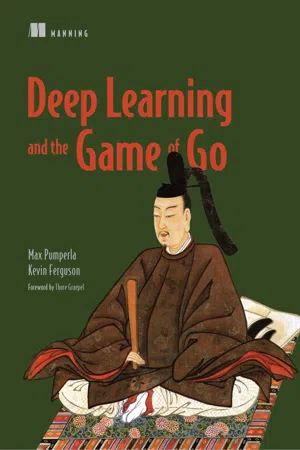
- 384 pages
- English
- ePUB (mobile friendly)
- Available on iOS & Android
Deep Learning and the Game of Go
About this book
Summary Deep Learning and the Game of Go teaches you how to apply the power of deep learning to complex reasoning tasks by building a Go-playing AI. After exposing you to the foundations of machine and deep learning, you'll use Python to build a bot and then teach it the rules of the game.Foreword by Thore Graepel, DeepMindPurchase of the print book includes a free eBook in PDF, Kindle, and ePub formats from Manning Publications. About the Technology The ancient strategy game of Go is an incredible case study for AI. In 2016, a deep learning-based system shocked the Go world by defeating a world champion. Shortly after that, the upgraded AlphaGo Zero crushed the original bot by using deep reinforcement learning to master the game. Now, you can learn those same deep learning techniques by building your own Go bot! About the Book Deep Learning and the Game of Go introduces deep learning by teaching you to build a Go-winning bot. As you progress, you'll apply increasingly complex training techniques and strategies using the Python deep learning library Keras. You'll enjoy watching your bot master the game of Go, and along the way, you'll discover how to apply your new deep learning skills to a wide range of other scenarios! What's inside
- Build and teach a self-improving game AI
- Enhance classical game AI systems with deep learning
- Implement neural networks for deep learning
About the Reader All you need are basic Python skills and high school-level math. No deep learning experience required. About the Author Max Pumperla and Kevin Ferguson are experienced deep learning specialists skilled in distributed systems and data science. Together, Max and Kevin built the open source bot BetaGo. Table of Contents
PART 1 - FOUNDATIONS
- Toward deep learning: a machine-learning introduction
- Go as a machine-learning problem
- Implementing your first Go bot
PART 2 - MACHINE LEARNING AND GAME AI
- Playing games with tree search
- Getting started with neural networks
- Designing a neural network for Go data
- Learning from data: a deep-learning bot
- Deploying bots in the wild
- Learning by practice: reinforcement learning
- Reinforcement learning with policy gradients
- Reinforcement learning with value methods
- Reinforcement learning with actor-critic methods
PART 3 - GREATER THAN THE SUM OF ITS PARTS
- AlphaGo: Bringing it all together
- AlphaGo Zero: Integrating tree search with reinforcement learning
Frequently asked questions
- Essential is ideal for learners and professionals who enjoy exploring a wide range of subjects. Access the Essential Library with 800,000+ trusted titles and best-sellers across business, personal growth, and the humanities. Includes unlimited reading time and Standard Read Aloud voice.
- Complete: Perfect for advanced learners and researchers needing full, unrestricted access. Unlock 1.4M+ books across hundreds of subjects, including academic and specialized titles. The Complete Plan also includes advanced features like Premium Read Aloud and Research Assistant.
Please note we cannot support devices running on iOS 13 and Android 7 or earlier. Learn more about using the app.
Information
Part 1. Foundations
1 Toward deep learning: a machine-learning introduction
- Machine learning and its differences from traditional programming
- Problems that can and can’t be solved with machine learning
- Machine learning’s relationship to artificial intelligence
- The structure of a machine-learning system
- Disciplines of machine learning
1.1. What is machine learning?


1.1.1. How does machine learning relate to AI?
- Logic production systems, which apply formal logic to evaluate statements
- Expert systems, in which programmers try to directly encode human knowledge into software
- Fuzzy logic, which defines algorithms to help computers process imprecise statements
1.1.2. What you can and can’t do with machine learning
- Traditional algorithms solve the problem directly. If you can directly write code to solve a problem, it’ll be easier to understand, maintain, test, and debug.
- You expect perfect accuracy. All complex software contains bugs. But in traditional software engineering, you expect to methodically identify and fix bugs. That’s not always possible with machine learning. You can improve machine-learning systems, but focusing too much on a specific error often makes the overall system worse.
- Simple heuristics work well. If you can implement a rule that’s good enough with just a few lines of code, do so and be happy. A simple heuristic, implemented clearly, will be easy to understand and maintain. Functions that are implemented with machine learning are opaque and require a separate training process to update. (On the other hand,...
Table of contents
- Deep Learning and the Game of Go
- Copyright
- Brief Table of Contents
- Table of Contents
- front matter
- Part 1. Foundations
- 1 Toward deep learning: a machine-learning introduction
- 2 Go as a machine-learning problem
- 3 Implementing your first Go bot
- Part 2. Machine learning and game AI
- 4 Playing games with tree search
- 5 Getting started with neural networks
- 6 Designing a neural network for Go data
- 7 Learning from data: a deep-learning bot
- 8 Deploying bots in the wild
- 9 Learning by practice: reinforcement learning
- 10 Reinforcement learning with policy gradients
- 11 Reinforcement learning with value methods
- 12 Reinforcement learning with actor-critic methods
- Part 3. Greater than the sum of its parts
- 13 AlphaGo: Bringing it all together
- 14 AlphaGo Zero: Integrating tree search with reinforcement learning
- Appendix A. Mathematical foundations
- Appendix B. The backpropagation algorithm
- Appendix C. Go programs and servers
- Appendix D. Training and deploying bots by using Amazon Web Services
- Appendix E. Submitting a bot to the Online Go Server
- Index
- List of Figures
- List of Tables
- List of Listings